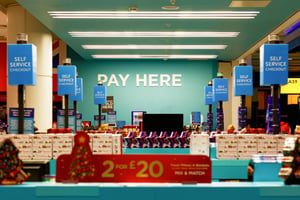
The advent of self-checkout stations has given retailers yet another reason to worry about loss prevention. Self-checkout is generally promoted to shoppers as a time-saver. But many customers are using these systems to save money, too — by stealing items instead of paying for them.
No longer a novelty, creative thieves (and frustrated shoppers) have now identified ways to bypass the proper self-checkout procedure. In fact, when it comes to helping yourself to unpaid-items, the self-help checkout offers multiple opportunities. They’re all easy, and they’re costing retailers whopping sums every year.
How are People Stealing via Self-Checkout?
If you’ve ever stood in a self-service line watching the folks ahead of you, you’ve probably witnessed some or all of these tricks, whether you realized it or not:
- Code switching: Putting an item on the scale that weighs about as much as a bunch of bananas but costs more, then punching in the UPC code for bananas.
- Label swapping: Covering the label of an expensive item with the bar code label of something cheap. Items have to be similar weights, or the machine will alert for an “unexpected item in the bagging area.” (Equipment is programmed to know typical product weights in order to detect anomalies.)
- "Forgetfulness": Purposely forgetting to scan large items on the lower cart rack.
- Sleight of hand: Moving items from the cart to a bag on the floor without scanning them; or doing that with one hand while actually scanning an item with the other.
Sure, there’s usually a store employee nearby. But they can’t watch half a dozen stations at once. The minute they are called away to help a shopper whose machine has misfired or to provide assistance elsewhere in the store, the coast is clear. Who’s to note their self-imposed discounts?
What Can Your Store do to Prevent Self-Checkout Theft?
- Follow in the footsteps of Albertson’s and Vons. They got so fed up, they eliminated self-checkout.
- Cut back on customer self-service opportunities, to enable better oversight.
- Don’t scrimp on staffing in these areas, even though that adds cost.
- More importantly, teach employees how to spot the various techniques customers are using to game the system.
- To augment increased human oversight, one tech company now makes video surveillance gear for self-help stations. Where traditional, built-in weight-based detectors won’t catch you failing to scan an item, the video will. That means a store employee will see it as well.
Retailers spend a lot of time agonizing about where to put their checkout counter. Location definitely affects shopper behavior and experience. But in grocery, big box, and similar high-volume operations, efficiency wins out over creative psychology. Checkout stations are near the exits. Perhaps that proximity makes it even more tempting for shoppers to give themselves a little discount at the self-checkout and make a quick getaway.
Whatever the motivations behind self-checkout theft, taking steps to make it more difficult and more detectable will help protect your bottom line without sacrificing convenience for paying customers.
